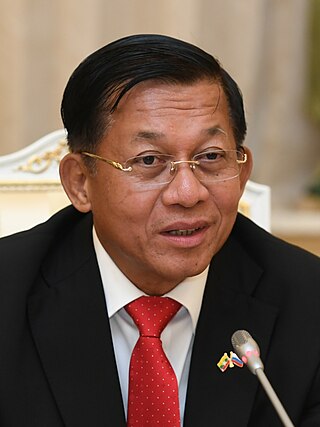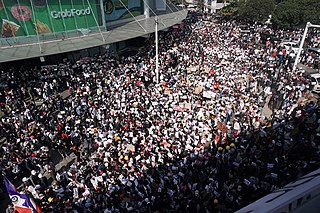
Yangon, formerly romanized as Rangoon, is the capital of the Yangon Region and the largest city of Myanmar. Yangon served as the capital of Myanmar until 2006, when the military government relocated the administrative functions to the purpose-built capital city of Naypyidaw in north central Myanmar. With over five million people, Yangon is Myanmar's most populous city and its most important commercial centre.

Hlaingthaya Township is located in the western part of Yangon, Myanmar. One of the biggest and most populous townships in the country with 15% of Yangon's urban population living there, Hlaingthaya also has a major industrial and factory presence. While Hlaingthaya is a largely working class suburb, developers have also built luxury housing developments in the southeastern part of the township.

Myanmar (Burma) and the United States had a diplomatic contact prior to the British colonial period. They established formal diplomatic relations in 1947 in anticipation of Burma's independence.
Myint Swe is a Burmese politician and retired army general currently serving as Acting President of Myanmar as well as First Vice President. He previously served as the acting president after the resignation of President Htin Kyaw on 21 March 2018, and the chief minister of Yangon Region from 30 March 2011 to 30 March 2016. On 30 March 2016, he was sworn in as the vice president of Myanmar. A member of the military proxy Union Solidarity and Development Party, he is an ethnic Mon former lieutenant general in the Myanmar Army.
Hlaing Township, also spelt Hline, is an area of Yangon, Myanmar in the West Yangon District of Yangon Region. The township is entirely urban and comprises 16 wards. In 2000, the township's population was estimated to be about 125,000.
Htantabin Township is a township located on the western border of central Yangon Region, Burma (Myanmar). Its administrative seat is Htantabin which is located in the southeastern part of the township on the western bank of the Hlaing River just south of its confluence with the Kokkowa River.

Min Aung Hlaing is a Burmese army general who has ruled Myanmar as the chairman of the State Administration Council since seizing power in the February 2021 coup d'état. He additionally appointed himself Prime Minister in August 2021. He has led the Tatmadaw, an independent branch of government, as the Commander-in-chief of Defence Services since March 2011, when he was handpicked to succeed longtime military ruler Senior General Than Shwe, who transferred leadership over the country to a civilian government upon retiring. Before assuming leadership over the Tatmadaw, Min Aung Hlaing served as Joint Chief of Staff from 2010 to 2011.
Kan Zaw is the current Union Minister for Ministry of Investment and Foreign Economic Relations. He previously served as Union Auditor General under Min Aung Hlaing. He was the Minister for National Planning and Economic Development of Myanmar from September 2012 to March 2016. From March 2011 to September 2012, he served as its deputy minister.
2021 (MMXXI) was a common year starting on Friday of the Gregorian calendar, the 2021st year of the Common Era (CE) and Anno Domini (AD) designations, the 21st year of the 3rd millennium and the 21st century, and the 2nd year of the 2020s decade.

A coup d'état in Myanmar began on the morning of 1 February 2021, when democratically elected members of the country's ruling party, the National League for Democracy (NLD), were deposed by the Tatmadaw — Myanmar's military — which then vested power in a military junta. Acting President of Myanmar Myint Swe proclaimed a year-long state of emergency and declared power had been transferred to Commander-in-Chief of Defence Services Senior General Min Aung Hlaing. It declared the results of the November 2020 general election invalid and stated its intent to hold a new election at the end of the state of emergency. The coup d'état occurred the day before the Parliament of Myanmar was to swear in the members elected in the 2020 election, thereby preventing this from occurring. President Win Myint and State Counsellor Aung San Suu Kyi were detained, along with ministers, their deputies, and members of Parliament.

The State Administration Council is the military junta currently governing Myanmar, established by Commander-in-Chief of Defence Services Min Aung Hlaing following the February 2021 coup d'état and the declaration of a state of emergency by the National Defence and Security Council. Under the constitution, the Commander-in-Chief holds absolute legislative, executive, and judicial power during a state of emergency. Min Aung Hlaing has delegated his legislative power to the SAC, which he chairs. It has formed a provisional administration, also led by Min Aung Hlaing as Prime Minister of Myanmar.

Protests in Myanmar, known locally as the Spring Revolution, began in early 2021 in opposition to the coup d'état on 1 February, staged by Min Aung Hlaing, the commander-in-chief of the country's armed forces, the Tatmadaw. As of 23 June 2022, at least 2000 protesters have been killed, 14,000 currently arrested and 700,000 displaced by the junta.
Aung Pyae Sone is a Burmese business tycoon who owns a number of major companies, including Sky One Construction Company and Aung Myint Mo Min Insurance Company. He is also reportedly the biggest shareholder in national telecoms carrier Mytel. He is the son of Senior General Min Aung Hlaing, the current leader of Myanmar, concurrently serving as Chairman of the State Administrative Council and Commander-in-Chief of the Myanmar Armed Forces.

The timeline of the 2021 Myanmar Revolution chronicles the 2021 Myanmar protests, known locally as the Spring Revolution, that began in early 2021 in opposition to the coup d'état on 1 February, staged by Min Aung Hlaing, the commander-in-chief of the country's armed forces, the Tatmadaw.

The People's Defence Force is the armed wing of the National Unity Government (NUG) in Myanmar. The armed wing was formed by the NUG from youths and pro-democracy activists on 5 May 2021 in response to the coup d'état that occurred on 1 February 2021 that put the military junta and their armed wing the Tatmadaw in power. The military junta designated it as a terrorist organisation on 8 May 2021. In October 2021, NUG's Ministry of Defence announced that it had formed a central committee to coordinate military operations across the country.
Kyu Kyu Hla, is a retired Burmese educator that served as lecturer at the Myanmar language department of Yangon University. Kyu Kyu Hla is the wife of Senior General Min Aung Hlaing, the 12th Prime Minister of Myanmar. She became Spouse of the Prime Minister of Myanmar following her husband's transition to Prime Minister on 1 August 2021, whereupon Min Aung Hlaing has ruled the nation as Chairman of the State Administration Council after the 2021 Myanmar coup d'état. She is also the honorary patron of Myanmar Women's Affairs.

The Myanmar civil war, also called the Burmese Spring Revolution, Burmese civil war or People's Defensive War, is an ongoing civil war following Myanmar's long-running insurgencies, which escalated significantly in response to the 2021 military coup d'état and the subsequent violent crackdown on anti-coup protests. As of February 2024, thousands of soldiers have surrendered without a fight, including six generals of the Tatmadaw, the regime’s military. A group of observers write that the Tatmadaw's forces remain "formidable and well-equipped", with "external allies and economic resources".

Following the 1962 coup d'état, Myanmar was ruled by a military dictatorship under which squatters were often evicted. In 2016, Aung San Suu Kyi led a civilian government and the first major eviction of squatters took place the following year at Hlegu Township, located northeast of Yangon; these squatters claimed they had bought their land legally.
The following is a timeline of major events during the Myanmar civil war (2021–present), following the 2021 military coup d'état and protests. It was also a renewed intensity in existing internal conflict in Myanmar.
Lieutenant General Nyunt Win Swe is a Burmese military officer and current commander of Myanmar's Yangon Command.













